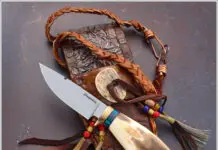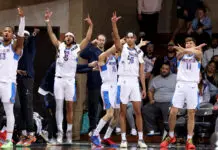The scissortail flycatcher may be Oklahoma’s official state bird, but it’s a lesser-known avian icon of the state that is at the center of a controversy making national news. The Lesser Prairie Chicken, once a plentiful species across the Sooner State whose exotic courtship rituals inspired the war dances of Plains Indian tribes, now teeters dangerously on the edge of existence. And as numbers decline, some fear that Oklahoma’s burgeoning wind-energy development is poised to provide the shove that sends the species careening into extinction.
A Species in Peril
According to Steve Sherrod, executive director of the Sutton Avian Research Center at the University of Oklahoma’s Biological Survey, Lesser Prairie Chickens have experienced a 97 percent decline in numbers range-wide since the 1800s and a 78 percent reduction in occupied range since 1963. The species seems locked in such a drastic downward spiral that the U.S. Fish and Wildlife Service is investigating whether to list the species as threatened and endangered under the Endangered Species Act – something both state conservationists and energy developers in the state are desperately trying to prevent.
“If the Lesser Prairie Chicken was lost, the associated loss of the functionality of the prairie ecosystem, of which the disappearance of lesser prairie would provide irrefutable proof, would be significant,” says Russ Horton, lands and wildlife diversity supervisor with the Oklahoma Department of Wildlife Conservation. “The prairie ecosystem provides ecological importance (carbon sequestration, erosion prevention, water quality), financial importance (ranching and recreation), and cultural importance (Native American history and culture, the American bison, and westward expansion). Most of these cannot be assigned a monetary value, and their true value is often not known or appreciated until it is lost.”
Everything from the encroachment of eastern red cedar to the planting of non-native grasses to global warming have been cited as reasons for the rapid loss of the prairie chicken’s habitat, but according to Sherrod, one of the biggest culprits is habitat fragmentation.
Sherrod compares the situation to a fishbowl with three goldfish. “First, you put in a little porcelain house, maybe a decorative fence, and all’s okay,” he says. “But then you put in four or five wind turbines, then relay stations, then maybe some transmission line poles. You keep putting in more and more. Before long, you still have a goldfish bowl. You still have water. But no place for the goldfish.”
It isn’t just the crowding of structures that make wind-power development such a player in habitat fragmentation. Research has shown that the Lesser Prairie Chicken instinctively avoids tall structures, including power poles and wind turbines, due to fear that predators roost there. Building these structures in the bird’s native habitat, researchers say, is guaranteed to deprive the Lesser Prairie Chicken of much-needed space to thrive.
What Price Conservation?
While State Rep. Gus Blackwell, R-Laverne, agrees that conscientious measures to preserve the Lesser Prairie Chicken should be considered, he cautions Oklahomans about the repercussions of the U.S. Fish and Wildlife Service placing the bird on the threatened and endangered species list.
“The economic impact of listing the Lesser Prairie Chicken would be devastating to the panhandle and to Oklahoma,” Blackwell says. “One out of every $4 in agriculture comes from the panhandle area. The area is rich in oil and gas. It also has been called the ‘Saudi Arabia of wind’ in terms of wind-energy economic development.”
Blackwell also does not entirely see eye to eye with some wildlife researchers regarding the severity of any dangers wind-energy development might pose to the species.
“The main problem is that there are still unproven assumptions made about the Lesser Prairie Chicken that would be applied to the historic habitat of this species,” Blackwell says. “One assumption is that they will not live near a tall structure. Since all oil and gas structures, wind generators or irrigation systems for farming all fall under these criteria, they all could be subject to a variety of consequences. These range from total denial of any more development to a long and tedious process of conservation analysis to allow a project to go forward.
“There is now no scientific study that shows that Lesser Prairie Chickens will not live around wind generators,” Blackwell continues. “In fact the opposite is true, with documentation that such symbiosis does exist. If one does not allow wind tower development then there should also be an end to drilling rigs, telephone poles, buildings and agricultural development.”
According to Blackwell, the U.S. Fish and Wildlife Department has not taken the necessary scientific measures and studies to accurately determine whether the Lesser Prairie Chicken has adapted to its changed environment in the Oklahoma panhandle. Instead, he maintains the department’s intensified scrutiny of the species’ population was prompted “in response to threatened lawsuits from the conservation community.”
In addition, Blackwell says that “to deny development of entire counties because of a single species is ludicrous.”
But according to Sherrod, the issue of development and the long-term, scientific study of its impact on the Lesser Prairie Chicken’s habitat is more complicated.
“Grouse, such as Lesser Prairie Chickens, generally avoid tall, vertical-type ‘structures’ ranging from red cedar trees to those built by humans, since these serve as perches for raptors and other predators,” he says. “Even though many of the high vertical structures used today are designed to prevent perching by birds of prey, the grouse do not realize this and are genetically programmed to avoid such construction.”
In addition, Sherrod says, “Anecdotal reports sometimes include instances of prairie chickens nesting near wind farms and other structures, but well-designed studies that examine the potential impacts of high vertical structures and other energy-related activities to prairie chickens and sage grouse are yet to be completed in both Kansas and Wyoming respectively. To add to the difficulty in assessing disturbances, results from studies can be confounded by the fact that impacts to grouse from anthropogenic activities on the landscape may not be fully realized for as many as 10 years post-construction.”
“There is quite a bit of evidence available indicating that prairie grouse need large (thousands of acres) tracts of land with native grassland vegetation that are not fragmented and not cluttered with red cedars or manmade tall structures; other species of grouse in Europe have proven sensitive to wind-farm activities as well,” Sherrod says. “Because wind-energy development in the American prairies is relatively new on the scene, however, and because locations for such activities have been very difficult to discover before construction, long-term scientific studies are either just now being initiated or are only currently underway.
“To responsibly evaluate the impact of this type of energy development on our own prairie chickens would seem prudent to accomplish prior to blindly undertaking activities that, judging from reactions by grouse in other parts of the world, will likely have a negative impact on our disappearing, cherished natural heritage.”
Finding A Compromise
While lines in the sand definitely have been drawn, the situation has not reached an all-out war yet. Conservationists, energy companies and legislators are working hard to find a mutually beneficial solution that will both provide long-term safety for the species and allow development.
“The biggest step toward saving the Lesser Prairie Chicken has been made by the Legislature in forming the Endangered Species and Economic Development Task Force,” Blackwell says. “This task force will combine the expertise of the Oklahoma State University agriculture scientific community with OU’s Sutton Avian Center’s experience. Together with the people whose livelihood depends on its care of the land, a solution will be found. This may be by designating specific wildlife areas as places where this bird can flourish. It may be by transplanting birds to specific areas near other “leks” [the prairie chicken’s grounds for mating and courtship rituals]. It may entail a variety of methods found to be successful.”
“What won’t work,” Blackwell contends, “is what has been done for the past 10 years by the U.S. Department of Fish and Wildlife. They have spent over $25 million in the last five years in simply ‘improving’ habitat. They ‘hope’ this will work and the Lesser Prairie Chicken will return. But it hasn’t worked in the past 10 years, and it won’t in the future. The answer is much more comprehensive than that. Oklahoma will do a better job in solving this problem as people who actually live in the Lesser Prairie Chicken’s habitat rather than by federal dictates from bureaucrats in Washington, D.C.”
Sherrod, who regularly advises the task force, sees no reason that responsible compromise on development can’t “let us have our cake and eat it, too.”
“We’re not against wind generators,” he says. “We favor putting them in plowed fields that have already been destroyed. Develop responsibly. Instead of putting them out there in the habitat and getting 100 percent energy, we could plant in other places and get 90 percent.”
On the energy side of the issue, OG&E seems to be leading the charge in walking the fine line between bringing new energy resources to Oklahoma and actively seeking solutions to helping the Lesser Prairie Chicken reclaim ground.
Thus far, the company has contributed $8.65 million to the Oklahoma Department of Wildlife Conservation to help offset the impacts of two wind-generation facilities in northwest Oklahoma. According to Horton, the money has been used for such initiatives as the purchase of more than 17,600 acres of Lesser Prairie Chicken habitat and a long-term lease of another 10,000 acres; the hiring of an energy issues biologist to work with the energy industry to promote conscientious development; the negotiation of habitat provision on private lands; and the hiring of a consultant to prepare a comprehensive Conservation Action Strategy and Recovery Plan for the Lesser Prairie Chicken. In addition, the funds will allow the Oklahoma Department of Wildlife Conservation to partner with the Oklahoma Association of Conservation Districts to develop a wildlife credits program to incentivize conservation of the Lesser Prairie Chicken on private lands.
“OG&E Energy Corporation takes its stewardship toward wildlife species in peril very seriously,” Trish Horn, vice president for governance, environmental health and safety for the company, recently stated in a forum with U.S. Fish and Wildlife Service Director Dan Ashe. “OG&E is interested in good science and good research that will bring the best results. OG&E believes that the state wildlife leaders in Oklahoma – specifically Secretary of Environment (Gary) Sherrer and the Oklahoma Department of Wildlife Conservation – are equipped with the expertise to accomplish the most effective results for protection, preservation and restoration of the Lesser Prairie Chicken.”
In addition to the donation of funds to help protect the species, some of OG&E’s upcoming projects, such as the Crossroads farm north of Canton, are being built in environments that will not impact the Lesser Prairie Chicken’s habitat.
The Oklahoma Department of Wildlife Conservation also has been hard at work to help bridge the gap between conservation and development. In response to the dilemma, the department has created the Oklahoma Lesser Prairie Chicken Spatial Planning Tool.
“This a web-based planning tool for any developer working in Lesser Prairie Chicken range to use to evaluate the potential ecological impact of a development on the Lesser Prairie Chicken and its habitat,” Horton says. “It is our intention that through utilizing the tool, the decisions the industry makes are as informed as possible concerning potential effects, either positive or negative, on Lesser Prairie Chickens and their habitats.”
A Murky Future
All parties agree that action must be taken to solve the problem of the Lesser Prairie Chicken, but as billions of potential dollars for Oklahoma and the fate of an entire species square off, a solution that will please all still seems elusive
.
“The greatest difficulty in solving this problem is the conservation community, which seems more interested in stopping development and less desire to see the birds in greatly increased numbers,” says Blackwell. “The U.S. Fish and Wildlife’s response has been a fanatic desire to follow the letter of the law and their rules. The end result of increasing numbers seems to be lost in their philosophical milieu. If they would allow Oklahoma time to implement strategies adopted by the state, then real progress could be realized.”
Horton sees conscientious development as the key. “There are plenty of places in northwest Oklahoma where energy development would have minimal or no impact on Lesser Prairie Chickens,” he says. “There are also places, however, where the effects of development would have a significant impact on the potential for long-term survival of the species. It is crucial that all stakeholders work together to protect these areas, and an integral part of that is to make sure that it remains financially appealing to landowners in those crucial areas to maintain populations of the Lesser Prairie Chicken.
“We must make sure, through whatever means available, that all stakeholders work together to maintain a suitable amount of high-quality habitat in sufficient quantities and locations, with functional connectivity to ensure long-term survival of the Lesser Prairie Chicken,” Horton continues.
“I have been fortunate to have traveled throughout the planet to watch wildlife,” Sherrod says, “and there is nothing better out there I’ve seen than to watch the Lesser Prairie Chickens on their leks. Nothing better. It’s just spectacular. We’re really doing our best to keep these glorious animals in our state.”
























